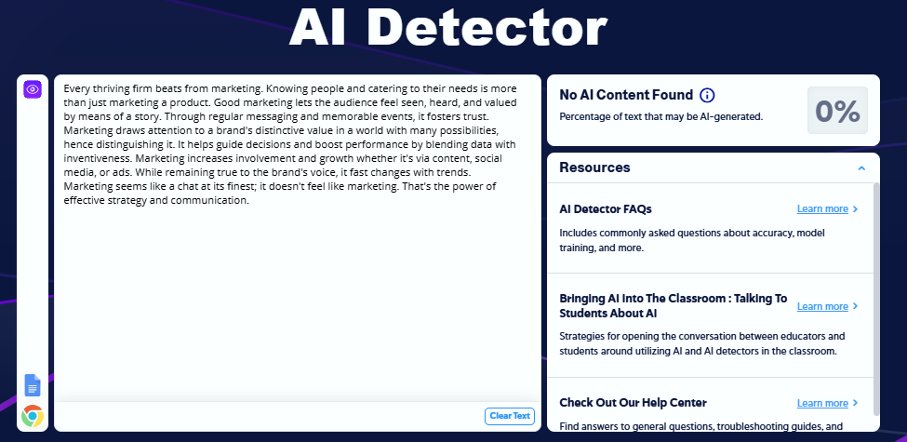
Artificial Intelligence has completely transformed the way we write. It has developed several AI tools, such as ChatGPT, DeepSeek, Gemini, and many others, that are efficient in instantly generating content around any type of topic. However, they are unable to perfectly mimic the human writing style. The content created from AI tools doesn’t feel natural, authentic, or truly human.
However, with the right ways, you can easily make AI content more natural and human-like. In this blog post, we have explored some simple yet powerful techniques that will help you transform AI and robotic tone into natural output that feels genuinely human.
Different Techniques to Make AI Content More Natural and Human-Like
There are several techniques through which you can transform AI content into natural-sounding one. Among them, we have explained some prominent and more useful text humanizing techniques in the sections below. Additionally, we have provided an advanced and automatic way, i.e., using an AI humanizer tool, in the end.
1. Include Figurative Words
One of the main differences between actual human and AI writing is the imagination. While AI tools can write logically and factually, they often cannot express ideas creatively or create vivid images with words. It commonly uses literal and rigid language. This is where using figurative language can make the difference.
Figurative language refers to the use of similes, metaphors, idioms, or analogies to express abstract or dry ideas in an emotionally engaging and imaginative way. Incorporating figurative words and phrases into your AI can make it feel more natural and human. Plus, it will give soul to your straightforward content.
Practical Example:
AI-Sentence:
“Consistency in blog posting will help your website gain better engagement.”
Humanized with Figurative Language:
“Consistency in blog publishing on a website is like watering a plant; if you are not seeing faster results, your growth is certain over time.”
The difference is obvious. The second sentence engages readers, creates imagery, and memorably conveys the same message.
2. Remove Overused or Generic Phrases
AI-generated content pieces mostly contain some overused, generic, and robotic-sounding phrases. These phrases are not just boring to read, but they feel like fillers and lifeless terms. In other words, these phrases feel like written by machines, not by a human writer.
Below are some examples of these phrases:
- “In today’s fast-paced digital world…”
- “This article will explore…”
- “It is important to note that…”
- “At the end of the day…”
- “In today’s world…”
And so on…
You should read AI content carefully, find out those phrases that seem unnecessary (have no value), and simply remove them.
3. Add Personal Experiences
One major shortcoming of AI content is that it lacks personal experiences. As we know, AI tools don’t live, feel, or have personal experiences; they’re just robots that produce information based on preset patterns and training data. This is why AI-generated content feels generic and impersonal.
To make your AI content sound more human-like and natural, add some first-hand or someone’s experiences. For this, you should carefully review AI-generated content and find the placements where you can naturally incorporate personal experiences or anecdotes.
For instance, instead of just writing that you faced challenges in handling new customers, you should share that time how you worked hard, stayed connected with customers, and what strategies you used to satisfy them. Adding real-human experiences will not only make your content sound more natural but also feel authentic and human-focused.
A Practical Example;

4. Avoid Complex Words & Phrases
AI content generators often use technical terms and structure to look smart, but this mostly results in unnatural and rigid writing. On the other hand, human writers commonly aim for simple, clear, and easy-to-understand writing.
Hence, another technique to transform your AI content into natural and human-like content is to simplify it.
Follow these tips to edit and simplify your AI content.
- Look for longer sentences and complex sentences in your content and break them into shorter ones.
- Replace specialized and complex terms with simple and everyday language, like “Leverage” with Use”, “Crucial with Important”, “Facilitate with help”, etc.
- AI tools mostly use passive voice. You should convert some passive sentences into active voice (as they are easier to read).
While simplifying the AI content, you should make sure that the actual intent or meaning is not changed. For this, you need to include only those words and phrases that fit best with the context of the original content.
Here’s the Practical Example:

5. Include Emotions
AI tools have no emotions; they don’t feel excited, astonished, joyful, or surprised by something. Their output content pieces often feel emotionally flat. That is another big opportunity for you to make it sound more natural.
You just need to add some emotional depth using sensitive and emotionally provoking language that could better address the feelings. Here are examples of some emotion words that you can use;
- Hopefully.
- Excited.
- Nervous.
- Overwhelmed.
- Worried.
- Frustrating.
While incorporating emotional words, ensure that they fit better in the actual context. Doing so will make your content more relatable, connected, and natural.
6. Advanced Technique: Use A Text Humanizer Tool
All the above-mentioned techniques demand manual efforts and a lot of time. Along with these, you need to have a stronger grip on writing. Despite that, the results are not guaranteed to be up to expectations. You may sometimes lose the actual context or fail to make content sound authentic and natural.
In this scenario, we decided to introduce you to an automatic method, i.e., using online text humanizing tools. These tools are particularly built to humanize AI-generated content pieces and make them sound like a real human wrote them. Nowadays, they are widely used by writers, researchers, and professionals to avoid robotic tone and incorporate authenticity in writing, while keeping the actual meaning intact.
Let’s give you a real-time demonstration of how these tools work. For this, we selected Editpad’s AI humanizer tool that we often use for refining AI content pieces. We just pasted an AI content from ChatGPT into the text humanizer and ran it. The tool quickly changes the provided AI writing into a natural, authentic, and more engaging output.
Image Showing AI Content Generated By ChatGPT;

Humanized Content Using Editpad AI Text Humanizer;

To ensure, we checked the output using an AI Detector, i.e., Copyleaks, to see if it is perfectly humanized into natural writing or not. The results are surprising, as you can see in the image below;

Conclusion
AI-generated content pieces mostly have a robotic tone that seems unnatural and detached. You need to refine them and make them feel natural and truly human-like writing. This is important to engage readers, build connections, and win the trust of the audience.
In this blog post, we walked you through different techniques that you can implement and make AI text sound natural. You can use figurative language, remove generic words, add personal experiences, and incorporate emotions. Besides these, we mentioned an advanced and instant way, i.e., using an online humanizer tool, along with a practical example.